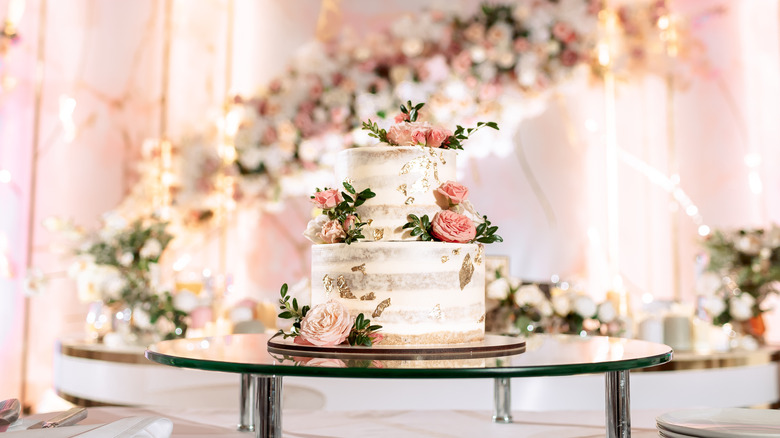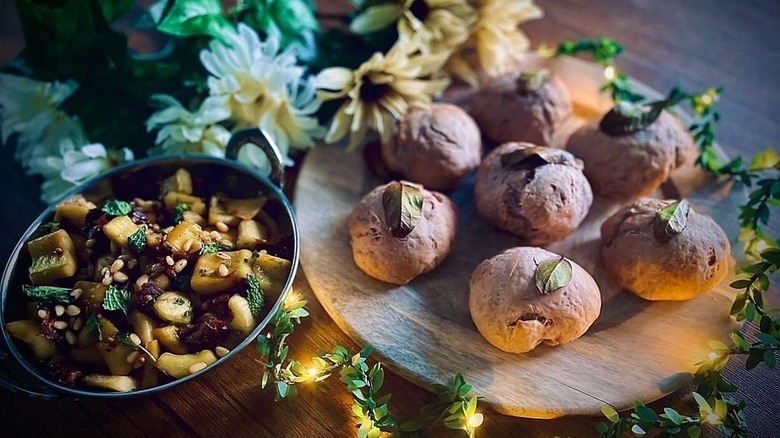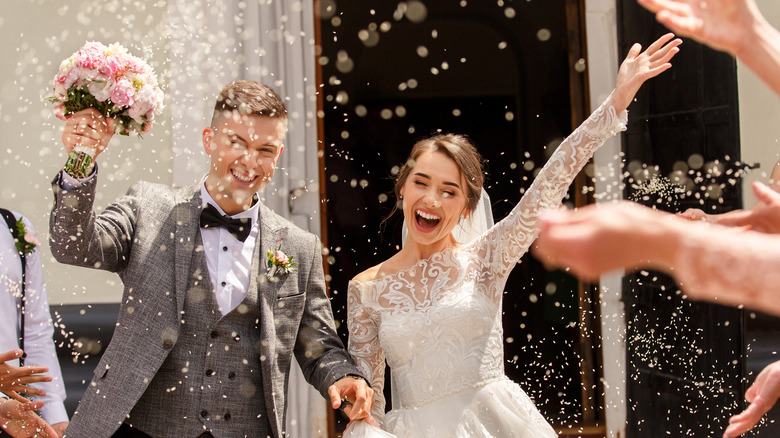Wedding Cakes Have Unexpectedly Ancient Origins
For couples planning a wedding today, choosing the perfect wedding cake can be as painstaking a decision as selecting their venue, dress, or color palette. That's because the wedding cake is more than just a tasty dessert. It's an often-expensive tool — though it is possible to have an all-star wedding cake on a budget — used to symbolically set the tone for a couple's married life. While many know the modern significance of a wedding cake, far fewer know that the consumption of culturally imbued cakes during wedding celebrations is a tradition dating back much further.
The first documented wedding cake tradition dates back to the Ancient Roman Empire when guests could expect a dry, grape-must cake called mustacei to be broken over the bride's head to enhance her fertility and bring the couple good luck. Thankfully, much about the lore surrounding wedding cakes has changed — today's wedding cakes are sweeter, more elaborate, and typically served to guests on plates, to name only a few distinctions. But they remain a delicious and culturally significant component of these celebrations to this day.
The ancient significance of wedding cake
Though undoubtedly a delicious way to cap off a declaration of eternal love, the wedding cake has held deeper symbolic significance since its origin. Ancient Roman brides weren't having cakes broken over their heads for the fun of it — so why did this become a common practice? Romans believed doing so brought good fortune in the couple's new life. One of their first acts as husband and wife would be eating the crumbs that fell together, called confarreatio, and the remaining crumbs would be collected by wedding guests so that they could share in the newlywed's good fortune and prosperity, too. Over time, the tradition softened somewhat and brides just had cakes crumbled overhead, but the intention behind the act stayed the same.
The traditions we trace back to Ancient Rome moved around the world as Roman conquests continued to unfold. When they put down roots in Britain in 43 A.D., their wedding cake tradition evolved into something new altogether. Rather than showering brides in cake crumbs — in Britain, brides were pelted with them to symbolize fertility and the growth of their new family. British royal etiquette may still be questionable, but it has certainly come a long way — throwing food is no longer encouraged at such esteemed gatherings.
Modern takes on ancient traditions
It's easy to chuckle at these ancient traditions, but they're not as distant as you may suspect. While no longer wistfully eating crumbs that have tumbled from the bride's head, modern wedding guests still gather to watch the bride and groom feed each other their first bites of wedding cake, symbolizing their commitment to providing and caring for one another. Many couples also continue the ancient legacy of making a proper mess of themselves by smashing cake into each other's faces. We can also clearly trace the evolution from showering newlyweds with cake crumbs to modern practices of throwing confetti or rice into the air as they leave their ceremony, signifying prosperity and fruitfulness in their marriage.
While specific wedding traditions and their cultural significance evolve over time, the core intention has remained the same for centuries. Couples solidify and celebrate their union surrounded by community, and those who gather to witness the union strive to lay a foundation of good fortune and joy for the couple in whichever symbolic or literal ways they know how. And of course, an esteemed dessert is typically served, bringing good luck to all who enjoy it — what else could eating something so delicious possibly signify?



